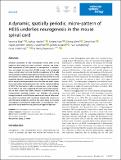Files in this item
A dynamic, spatially periodic, micro-pattern of HES5 underlies neurogenesis in the mouse spinal cord
Item metadata
| dc.contributor.author | Biga, Veronica | |
| dc.contributor.author | Hawley, Joshua | |
| dc.contributor.author | Soto, Ximena | |
| dc.contributor.author | Johns, Emma | |
| dc.contributor.author | Han, Daniel | |
| dc.contributor.author | Bennett, Hayley | |
| dc.contributor.author | Adamson, Antony D | |
| dc.contributor.author | Kursawe, Jochen | |
| dc.contributor.author | Glendinning, Paul | |
| dc.contributor.author | Manning, Cerys S | |
| dc.contributor.author | Papalopulu, Nancy | |
| dc.date.accessioned | 2021-05-26T09:30:02Z | |
| dc.date.available | 2021-05-26T09:30:02Z | |
| dc.date.issued | 2021-05-01 | |
| dc.identifier | 274358433 | |
| dc.identifier | a77fa4af-bc43-4b5d-a5dd-3155fafa4600 | |
| dc.identifier | 85106958936 | |
| dc.identifier | 000655479400002 | |
| dc.identifier.citation | Biga , V , Hawley , J , Soto , X , Johns , E , Han , D , Bennett , H , Adamson , A D , Kursawe , J , Glendinning , P , Manning , C S & Papalopulu , N 2021 , ' A dynamic, spatially periodic, micro-pattern of HES5 underlies neurogenesis in the mouse spinal cord ' , Molecular Systems Biology , vol. 17 , no. 5 , e9902 . https://doi.org/10.15252/msb.20209902 | en |
| dc.identifier.issn | 1744-4292 | |
| dc.identifier.other | RIS: urn:390C0BD611B0073D79C8EF03EDAD4FB4 | |
| dc.identifier.other | ORCID: /0000-0002-0314-9623/work/94669927 | |
| dc.identifier.uri | https://hdl.handle.net/10023/23252 | |
| dc.description | CM was supported by a Sir Henry Wellcome Fellowship (103986/Z/14/Z) and University of Manchester Presidential Fellowship. VB was supported by a Wellcome Trust Senior Research Fellowship to NP (106185/Z/14/Z). JH (220001/Z/19/Z), EJ (204057/Z/16/Z) and DH (Wellcome Trust Grant No. 215189/Z/19/Z) were supported by Wellcome Trust PhD studentships. JK was supported by Wellcome Trust Senior Research Fellowship to NP and a University of St Andrews Lectureship. | en |
| dc.description.abstract | Ultradian oscillations of HES Transcription Factors (TFs) at the single-cell level enable cell state transitions. However, the tissue-level organisation of HES5 dynamics in neurogenesis is unknown. Here, we analyse the expression of HES5 ex vivo in the developing mouse ventral spinal cord and identify microclusters of 4?6 cells with positively correlated HES5 level and ultradian dynamics. These microclusters are spatially periodic along the dorsoventral axis and temporally dynamic, alternating between high and low expression with a supra-ultradian persistence time. We show that Notch signalling is required for temporal dynamics but not the spatial periodicity of HES5. Few Neurogenin 2 cells are observed per cluster, irrespective of high or low state, suggesting that the microcluster organisation of HES5 enables the stable selection of differentiating cells. Computational modelling predicts that different cell coupling strengths underlie the HES5 spatial patterns and rate of differentiation, which is consistent with comparison between the motoneuron and interneuron progenitor domains. Our work shows a previously unrecognised spatiotemporal organisation of neurogenesis, emergent at the tissue level from the synthesis of single-cell dynamics. | |
| dc.format.extent | 27 | |
| dc.format.extent | 5128464 | |
| dc.language.iso | eng | |
| dc.relation.ispartof | Molecular Systems Biology | en |
| dc.subject | Hes5 | en |
| dc.subject | Neurogenesis | en |
| dc.subject | Notch | en |
| dc.subject | Oscillations | en |
| dc.subject | Patterning | en |
| dc.subject | QA Mathematics | en |
| dc.subject | QH301 Biology | en |
| dc.subject | RC0321 Neuroscience. Biological psychiatry. Neuropsychiatry | en |
| dc.subject | DAS | en |
| dc.subject.lcc | QA | en |
| dc.subject.lcc | QH301 | en |
| dc.subject.lcc | RC0321 | en |
| dc.title | A dynamic, spatially periodic, micro-pattern of HES5 underlies neurogenesis in the mouse spinal cord | en |
| dc.type | Journal article | en |
| dc.contributor.institution | University of St Andrews. Applied Mathematics | en |
| dc.identifier.doi | https://doi.org/10.15252/msb.20209902 | |
| dc.description.status | Peer reviewed | en |
This item appears in the following Collection(s)
Items in the St Andrews Research Repository are protected by copyright, with all rights reserved, unless otherwise indicated.

